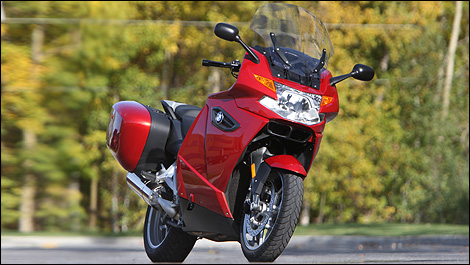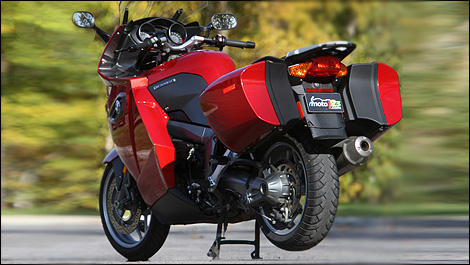Comparison testing of the leading Sport Touring bikes has often shown that the BMW K1200GT (At the time) and the current K1300GT are the most sophisticated models in that segment, and at a base pricing close to the direct competitors. After a ride on the new 1300 version, I certainly agree with that statement.
 |
| The bike appears wide, but is not unduly so, while still providing plenty or room and protection for rider and passenger. |
So why such a positive reaction when climbing aboard? It is always a question of feel for me – right riding position, right displays, comprehensive equipment, and overall quality and soundness, and performance as much as will ever need. This was my first time aboard the 1300 version of the GT model, and it looked to me like the transformation from 1200 to 1300 works well enough to be highly noticeable when you ride it.
Love that motor
The extra 136cc over the earlier K1200GT have been transformed into an extra 8hp, to 160 at 9,000 rpm from 152 at 9,500 rpm, and extra torque across the rev range, with a new maximum of 99 lb-ft at 8,000 rpm compared to 96 at 7,750 for the older model. These numbers are impressive, but the most significant one is that 80% of maximum torque is now available from 3,500 rpm all the way up to peak revs.
The six speed gearbox has successfully been updated to ease shifting, and the clutch is now the lightest I have used on a big-inch bike. The upgraded ECU programming works effectively with the balance shaft to provide a vibration- and bucking-free flow of power in all circumstances, from 2,000 rpm on a busy street to brewing up a storm on your favourite back road.
A chassis to match its Go Power
When it comes to suspension, the big K continues to shine on all fronts. The exclusive and well known Duolever front suspension uses A-frames to control the fixed length fork tube, eliminating the bending loads on fork tubes under braking that cause “Stiction” on classic fork assemblies. This means a more sensitive suspension, one that reacts to and dampens even the smallest ripples on the road.
 |
| I loved the cavernous and easily removed saddlebags. |

